|
Junior
Cashwell (Quitman, Georgia)
 Alton
Hamlin (left) and Junior Cashwell (right) in slide
1, enriched my life one Saturday morning. I thank both
of them: Alton for guiding me around, and Junior for being
there as the object of our trip. Both are down-to-earth
genial fellows, possessing traits sorely missed in this
fast-paced, consuming world. Alton and Junior are each
dedicated to his respective avocation, and we spent some
time catching up on Junior’s activities. Alton
Hamlin (left) and Junior Cashwell (right) in slide
1, enriched my life one Saturday morning. I thank both
of them: Alton for guiding me around, and Junior for being
there as the object of our trip. Both are down-to-earth
genial fellows, possessing traits sorely missed in this
fast-paced, consuming world. Alton and Junior are each
dedicated to his respective avocation, and we spent some
time catching up on Junior’s activities.
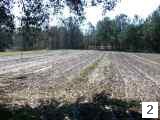 We
found Junior while he was working on a new irrigation
system near his cane patch (Slide
2). His system for planting cane is another variation
and of interest. His rows are spaced 52” inches apart.
Cane and peas alternate so that he can drive down each
cane row for ease of harvesting. He puts 400 pounds/acre
in March of a 3-9-9 or 4-8-12, a tobacco-type fertilizer
that is low in nitrogen. Junior grows various kinds of
cane (“a white cane from Florida,” “ribbon cane,”
and a “local cane”). We
found Junior while he was working on a new irrigation
system near his cane patch (Slide
2). His system for planting cane is another variation
and of interest. His rows are spaced 52” inches apart.
Cane and peas alternate so that he can drive down each
cane row for ease of harvesting. He puts 400 pounds/acre
in March of a 3-9-9 or 4-8-12, a tobacco-type fertilizer
that is low in nitrogen. Junior grows various kinds of
cane (“a white cane from Florida,” “ribbon cane,”
and a “local cane”).
Peas, mentioned above, are Vigna
unguiculata . As any southerner knows, they come in
wondrous variety (to mention a few, purple hull, crowder,
zipper cream). Proper praise of this plant would not fit
here. They are delicious and nutritious. In addition, peas
associate with Rhizobium to reduce dinitrogen, have extra
floral nectaries, and require less fertility and water
than most vegetables. (Regrettably, they are susceptible
to nematodes, and curculio larvae do not add to their eye
appeal.) Folks outside the south call peas cowpeas or
southern peas to distinguish them from what we call garden
peas or green peas (Pisum sativum).
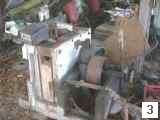 After
leaving Junior’s cane patch, we crossed his wooden
bridge and stopped by one of his open sheds where
treasures, pure and simple, waited for attention. The
first of these was a grist mill (Slide
3), and then a disassembled Chattanooga 44 (Slide
4) with a roller (Slide
5) that had been repaired long ago in anticipation of
working again. As we left, a 60-gallon Columbus kettle (Slide
6), was sitting ready to scald hogs, which was its job
[See also Mark Watson ]. After
leaving Junior’s cane patch, we crossed his wooden
bridge and stopped by one of his open sheds where
treasures, pure and simple, waited for attention. The
first of these was a grist mill (Slide
3), and then a disassembled Chattanooga 44 (Slide
4) with a roller (Slide
5) that had been repaired long ago in anticipation of
working again. As we left, a 60-gallon Columbus kettle (Slide
6), was sitting ready to scald hogs, which was its job
[See also Mark Watson ].
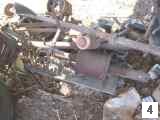
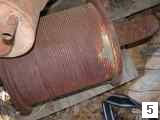
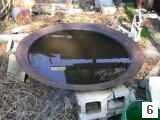
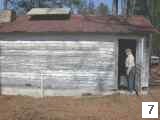 Junior
(standing in door) has a very attractive and rustic syrup
shed (Slide
7). Junior
(standing in door) has a very attractive and rustic syrup
shed (Slide
7).
Cane is pressed on a Chattanooga
72 (Slides 8
and 9),
which is just outside the shed. The juice is collected and
pumped (Slide
10), into the shed. (Junior tried filtering the juice
with a swimming-pool filter (shown in picture, but
disconnected), in an effort to reduce skimming, but the
filter clogged frequently and that idea was discarded.)
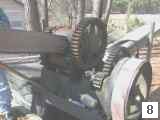
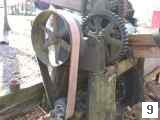
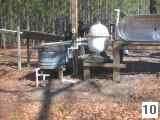
Junior cooks on a 100-gallon
Golden kettle (Slide
11). The kettle is mounted in a massive furnace with a
sloping concrete ledge that extends from the rim of the
kettle. This arrangement permits him to start with 120
gallons of juice, which is cooked down with wood (Slide
12). A wide variety of the tools used to cook the
syrup is shown on the wall near the kettle (Slide
13).
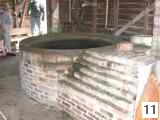
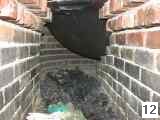
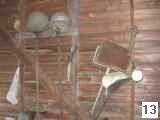
|